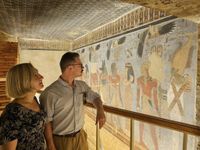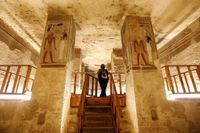After more than two decades behind closed doors, the tomb of Pharaoh Amenhotep III in Egypt’s famed Valley of the Kings has finally reopened to visitors, marking a significant milestone for both the country’s cultural heritage and its vital tourism sector. The official ceremony, held on October 4, 2025, in Luxor, was attended by Egypt’s Minister of Tourism and Antiquities Sharif Fathi, senior Egyptian officials, and representatives from UNESCO and the Japanese government—key partners in the restoration project.
This reopening comes at a crucial time for Egypt, as the nation prepares to inaugurate the Grand Egyptian Museum near the Giza Pyramids on November 1, 2025. According to the Associated Press, these high-profile events are part of a broader campaign to revive Egypt’s tourism industry, which has faced significant challenges since the political upheaval of 2011.
The tomb, known to archaeologists as WV22, belonged to Amenhotep III, a ruler of the Eighteenth Dynasty who reigned from 1390 to 1350 BCE. His era is often described as a golden age of Egyptian power and prosperity, marked by monumental building projects and extensive diplomatic ties stretching from Nubia to Syria. Amenhotep III, who ascended the throne as a teenager following the death of his father Thutmose IV, presided over nearly 40 years of peace and artistic achievement, much of it centered in Thebes rather than the traditional capital, Memphis (as reported by Eastleigh Voice and Enyichukwu Enemanna).
Discovered in 1799, the tomb is located on the western side of the Valley of the Kings, opposite modern-day Luxor. Over the centuries, it suffered from natural erosion, structural instability, and repeated looting—including the removal of the pharaoh’s sarcophagus. Today, the remains of Amenhotep III are housed at the National Museum of Egyptian Civilization in Cairo, alongside 16 other royal mummies, after being relocated during the 21st Dynasty to the tomb of his grandfather, Amenhotep II (as detailed by the Associated Press and Science X Network).
Described by Mohamed Ismail Khaled, Secretary-General of Egypt’s Supreme Council of Antiquities, as “one of the most important and prominent” tombs in the Valley of the Kings, WV22 extends 36 meters deep into the rock and features a central burial chamber flanked by rooms intended for his Great Royal Wife, Tiye, and daughter, Sitamun. The tomb’s walls are renowned for their vibrant murals, which depict Amenhotep III in the company of ancient Egyptian gods such as Osiris and Ra, as well as scenes from the Book of the Dead—a collection of spells meant to guide the deceased through the underworld. Notably, the burial chamber’s ceiling is painted a deep blue, adorned with golden stars to symbolize the heavens.
The restoration of WV22 was a truly international effort, led by a Japanese-funded team in collaboration with UNESCO, Waseda and Higashi Nippon Universities of Japan, and Egypt’s Supreme Council of Antiquities. The project, titled “Preserving the Murals of the Tomb of King Amenhotep III,” spanned more than 20 years and unfolded in three distinct phases: 2001–2004, 2010–2012, and 2023–2024. According to the Greek Reporter, specialists from Egypt, Japan, and Italy contributed expertise in mural conservation, stone restoration, 3D scanning, and structural engineering.
One of the project’s most challenging tasks was the reassembly of more than 200 fragments of the pharaoh’s red granite sarcophagus lid, which had been shattered and scattered over the centuries. Restoration teams also cleaned and stabilized the tomb’s intricate murals, many of which had suffered severe deterioration due to humidity and structural weakness. “This was incredibly delicate work. The tomb had suffered from structural instability and moisture damage. In some places, pigments were literally falling off the wall,” Mohamed Ismail Khaled told Eastleigh Voice. To ensure the preservation of these fragile artworks, advanced imaging and precision stabilization techniques were employed throughout the process.
Egyptian restorer Mohamed Mahmoud, who has worked on the site since the early stages of the project, described witnessing the tomb’s reopening as “a dream come true” after dedicating much of his professional life to the endeavor (according to the Greek Reporter). The project’s completion was marked by the installation of new information panels and lighting, enhancing the visitor experience and helping guests understand the tomb’s history and layout.
The tomb’s decorations, described by Khaled as “unique” and “colored inscriptions depicting religious and symbolic scenes of the king’s journey in the afterlife,” have been restored to their former brilliance. The artistry on display reflects the cultural and artistic prosperity of the New Kingdom period, setting WV22 apart as a masterpiece of ancient Egyptian craftsmanship (as reported by Enyichukwu Enemanna).
The reopening of Amenhotep III’s tomb is more than just an archaeological milestone; it’s a strategic move for Egypt’s economy. Heritage tourism accounts for nearly 12 percent of the nation’s GDP, and the government hopes that renewed interest in its ancient treasures will help boost visitor numbers after years of decline. According to the Associated Press, the sector has struggled since the 2011 uprising, but officials are optimistic that events like this will help Egypt reclaim its status as a top global destination for travelers seeking history and culture.
The ceremony itself was a showcase of international cooperation, with Minister Sharif Fathi expressing gratitude to UNESCO and the Japanese government for their longstanding partnership in preserving Egypt’s heritage. He called the reopening “a remarkable example of Egyptian–Japanese cooperation” and praised the dedication of the restoration teams who spent over 20 years on the project (as reported by the Greek Reporter).
As visitors once again descend the tomb’s 36-meter-long, 14-meter-deep passageway, they are greeted by vivid scenes of Amenhotep III’s journey to the afterlife, now illuminated by state-of-the-art lighting. The tomb’s main chamber, with its star-studded blue ceiling, offers a glimpse into the spiritual beliefs and artistic achievements of one of Egypt’s greatest pharaohs. For many, the reopening is not just about the past—it’s a hopeful sign for the future of Egyptian tourism and cultural preservation.
With the Grand Egyptian Museum’s long-awaited opening just around the corner, Egypt is making a bold statement about its commitment to safeguarding its ancient legacy while inviting the world to rediscover its wonders. The restoration of Amenhotep III’s tomb stands as a testament to what can be achieved through international collaboration, scientific innovation, and a shared respect for history.
As the first groups of visitors step into the newly restored tomb, they’re not just witnessing the splendor of a bygone era—they’re taking part in Egypt’s ongoing story, one that continues to captivate and inspire, thousands of years after Amenhotep III’s reign.





